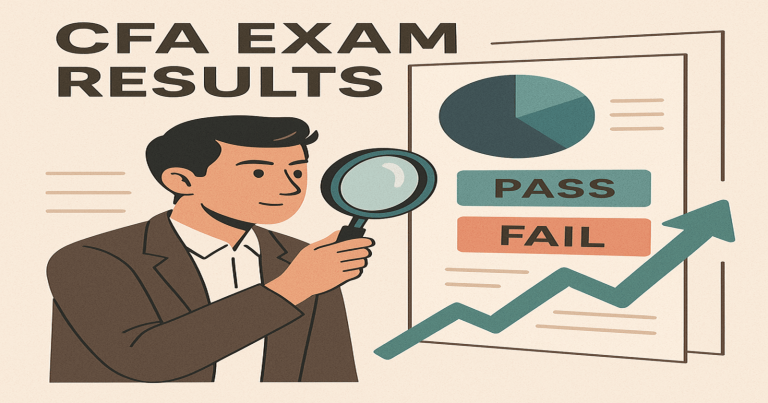Every CFA candidate waits eagerly for their CFA exam results. This is not just another test outcome. It reflects the hard work, time, and focus you have put into one of the most competitive financial exams in the world. Whether you are preparing for CFA Level I or have just completed Level III, understanding how the result system works can give you clarity and confidence.
Many Indian students who are pursuing finance careers see the CFA Program as a way to open global doors. However, the tension that surrounds the exam does not end until you get that result email. The waiting period becomes difficult. So, it is important to know what to expect.
How CFA Exam Results are Released?
Many candidates are confused about when CFA results will be available. The exam is computer-based, but grading still takes time because it involves performance analytics and review, especially for Level III.
Timeline and Process
The CFA Institute usually releases the results about 6-8 weeks after the CFA exam for Level I and II. For Level III, which includes essay-type responses, results may take 8–10 weeks. The result email usually arrives at 9:00 AM Eastern Time (6:30 PM IST).
Here’s a clearer breakdown of the expected timeline:
| Level | Exam Months | Result Timeframe |
| Level I | Feb, May, Aug, Nov | 6–8 weeks post-exam |
| Level II | Feb, Aug | 6–8 weeks post-exam |
| Level III | May, Nov | 8–10 weeks post-exam |
Result Delivery Methods
- Email Notification: CFA Institute sends an email with the result to the registered email ID. Keep checking both inbox and spam folders.
- Candidate Portal: You can also log in to the CFA Institute website and check the “My Account” or “Candidate Resources” section.
- Website Overload: On the day of the result, many users try logging in at once. The website may become slow. Try refreshing or waiting a few minutes.
Result Format
- Pass/Fail: Level I and II results simply state “Pass” or “Did Not Pass.”
- Detailed Matrix for Level III: The result includes a performance breakdown into three bands – below 50%, 51–70%, and above 70%.
Understanding your performance section-wise helps you identify topics where you did well and where you need improvement.
How the CFA Minimum Passing Score (MPS) Works?
CFA exams do not follow a fixed percentage rule for passing. Instead, they use something called the Minimum Passing Score (MPS). Understanding the minimum passing score (MPS) is key to knowing how CFA exam results work. The MPS is the lowest score you need to pass the exam. However, the CFA Institute never publishes the exact MPS.
What Is MPS and Why It Is Hidden
The CFA Institute sets the MPS after each exam. This means there is no fixed cut-off, like 70% or 60%. Instead, experts review the exam and set the score based on how tough that session’s questions were.
- Adjusts for difficulty: MPS changes depending on how hard or easy the paper is.
- Keeps standards fair: This ensures no group has an unfair advantage.
Even though the exact MPS is secret, candidates assume it lies between 65% to 70%. However, this is only a guess.
How CFA Decides the Passing Score
The CFA Institute uses a standard-setting process. This means experts review the exam and set a passing score based on how difficult the questions were. They adjust the score each time to match exam difficulty.
Usually, students believe the MPS lies between 65% and 70%, but this is not confirmed. This score may also differ slightly for each level and session.
Performance Bands
The CFA Institute provides a band-wise report:
- Above 70%: Strong performance. You understood and applied the concepts well.
- 51%–70%: Average performance. You have some gaps in application or accuracy.
- Below 50%: Weak performance. You must focus more on these areas in your next attempt.
This format helps candidates understand their strengths and weaknesses.
How to Check CFA Exam Results
The process of checking your CFA exam results is simple, but on the result day, it can get stressful due to site delays and anxiety.
Step-by-Step Process
- Visit the CFA Institute Website: Go to cfainstitute.org on your browser.
- Log In: Use your registered email and password.
- Go to Dashboard: Find the section titled “Candidate Resources” or “My CFA.”
- Click on Results Tab: Once the results are live, a new tab or button appears.
- Check Status: It will either say, “Congratulations! You passed.” or “You did not pass.”
- Download PDF or Screenshot: Save the result for your records and future planning.
Important Tips
- Check Email & Portal: If the email is delayed, check your CFA account directly.
- Use a Stable Internet Connection: The result page may crash on mobile; use a desktop if possible.
- Be Ready for Delay: Sometimes, the results may take a few minutes to reflect.
Understanding how to check your result helps reduce panic and saves time on the result day.
What To Do After CFA Exam Results?
Your journey doesn’t end once the result is out. What you do after getting the result matters even more. You need to plan your next move—whether you passed or failed.
If You Passed
Celebrate, but plan your next steps quickly. Every CFA level gets harder.
- If you passed Level I: Begin preparing for Level II. The topics become more analytical and data-focused.
- If you passed Level II: Register early for Level III. Learn how to write essay-style responses, which is key at this stage.
- If you passed Level III: Start the process of becoming a CFA charter holder. Apply for membership, submit 4 years of relevant work experience, and provide two professional references.
If You Failed
Don’t get discouraged. Many successful CFAs have failed once or twice.
- Analyze Your Score Matrix: Identify areas where you scored below 50%.
- Change Your Strategy: Try new study materials or coaching. Practice more mock exams.
- Register for Next Attempt: Don’t wait too long. Prepare while concepts are still fresh.
Tips for a Smart Next Step
- Take a short break before restarting prep. A fresh mind works better.
- Make a new plan based on your strengths and weak topics.
- Focus more on practice-based learning and application.
Common Mistakes After CFA Results
Many students make poor decisions after their CFA exam results. Avoiding these mistakes can help you perform better in the next attempt or move forward smoothly.
Mistakes to Avoid
- Waiting Too Long: After the results, you must start planning. Delaying can cause a loss of momentum.
- Repeating the Same Study Method: If your previous strategy did not work, change it. Try flashcards, concept videos, or mock tests.
- Ignoring Performance Matrix: The topic-wise performance shows your weak areas. Use it to shape your new study plan.
- Skipping Ethics Section: Ethics plays a big role in borderline results. Focus more on Ethics in future prep.
- Not Taking Mock Tests: Practicing in an exam-like setting improves time management and confidence.
- Panicking or Overthinking: One result doesn’t define you. Stay focused on your goal.
CFA Exam Results FAQs
Q1. When are CFA exam results usually released?
6-8 weeks after the exam for Level I and II. Level III takes about 8-10 weeks.
Q2. Is the CFA passing score fixed?
No. The CFA Institute sets a unique minimum passing score after every exam.
Q3. Can I appear for the next exam immediately if I fail?
Yes, but CFA rules require a 6-month gap between two attempts at the same level.
Q4. What should I do if I fail CFA Level I?
Check your weak areas and make a new study plan. Join a coaching class if needed.
Q5. Does the CFA Institute allow re-evaluation of results?
No, CFA exam papers are not re-evaluated or rechecked.
Q6. Can I apply for CFA Level II without passing Level I?
No. You must pass Level I first to register for Level II.
Q7. What happens if my result email does not arrive?
Log in directly to the CFA website and check the “Candidate Resources” section.


